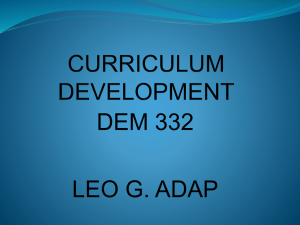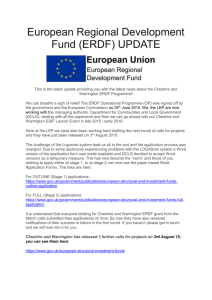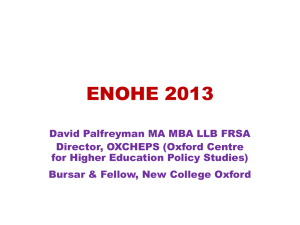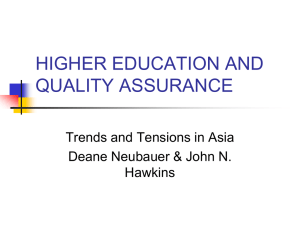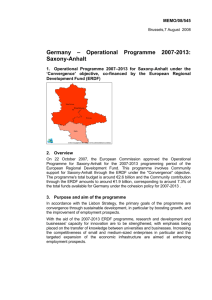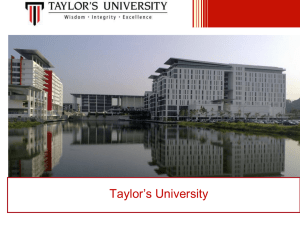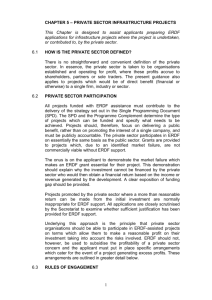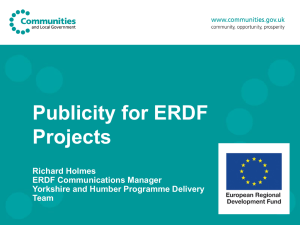ERDF Overheads - Northwest Universities European Unit Ltd
advertisement
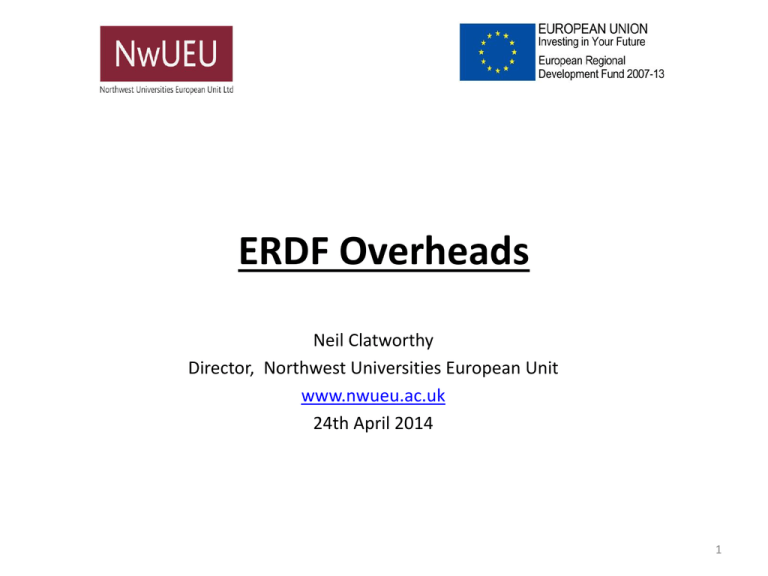
ERDF Overheads Neil Clatworthy Director, Northwest Universities European Unit www.nwueu.ac.uk 24th April 2014 1 Increased scrutiny of overheads: Recent DG Regio and ECA audits have highlighted the fact that in many cases, ineligible costs have been included in the calculation of overheads for ERDF projects. “The inability of the organisations concerned to provide an audit trail for overheads tested through to defrayal, or use of apportionment methods not acceptable to the EU resulted in significant percentage of allocated funds being clawed back”. “Due to the complexity of calculating and accurately recording and reporting overhead costs, Grant Recipients are strongly advised to consider whether their inclusion will add value to the ERDF project”. National ERDF Handbook states: DCLG is therefore minded towards adopting a flat-rate approach for 2014-20. In our view there is a strong argument that for the HEI sector it is still worth the cost of calculating an eligible ERDF overhead rate. 2 Direct charging or overhead? Wherever possible it is simplest to charge as many items/types of expenditure as direct costs: Can provide a better cost recovery against some items. Can provide a simpler and more direct audit trail. However not all costs or services (for example finance office, HR, estates & utilities, IT support etc.) can be easily charged on a direct basis especially when costs need to be linked back to defrayment. For HEIs, relevant indirect costs can however be charged against an ERDF project via agreed methodologies for fair and equitable apportionment. 3 Why are Indirect costs important? Indirect costs for HEIs are relatively significant and need to be reflected in project costs. They are after all real costs! Maintain consistency with in-house finance systems and audit trails. The agreed methodologies for calculating indirect costs are all based on the process for Full Economic Costing that all HEIs undertake annually to calculate overhead rates for related activities (e.g. research). There is however additional effort required due to the need for extra ‘filtering’ of ERDF ineligible costs: – you do need to make friends with your colleague(s) in Finance responsible for TRAC! 4 Ability to alignment with in-house financial systems - TRAC TRAC is designed to enable HEIs to demonstrate the ‘true cost’ of their activities. TRAC is a methodology that consolidates all central costs – e.g. Finance, Estates, HR, IT services etc. – enabling the calculation of an annualised indirect cost per FTEs. TRAC rates are calculated annually by every HEI based on institutional annual accounts. 5 Current HE ERDF Overhead Methodology: For ERDF activities HEIs derive a rate using the TRAC methodology as a basis and then apply extra filters to remove ERDF ineligible elements – for example: Amounts charged to ineligible or irrelevant cost centres/activities through the TRAC model. Any direct staff and non-pay costs charged directly to projects The charge for buildings depreciation funded from the release of deferred capital grants. The cost of Capital and Infrastructure adjustments Any items that are deemed ineligible for ERDF grant support. Any items which cannot be evidenced as relating to/consumed by the project. 6 ‘Real’ cost or Flat rate - Key Pros / Cons ‘Real’ Cost Annual Calculation Subject to on-going audit Typically derives higher recovery rates of 60-80% direct (staff) costs. Provides a potential source of significant match-funding for ERDF (revenue) projects. Flat Rate One time calculation based on a single year Agreed and finalised on application Max rate of up to 20% of direct costs Does not tie back to TRAC and sits outside main financial costing system Lancaster University & NWUEU have helped a number of wider HEIs derive compliant methodologies across the country – rates vary between HEIs, with some higher for more urbanised HEIs (Greater London). Once you have derived the internal filters it’s a relatively simple process to update and re-run on an annualised basis. 7 Is it worth it? The view by a number of HEIs is that the initial ‘pain’ is worth it – better recovery / ability to use overheads as match should not be underestimated. For many Universities losing the ability to match overheads at the ‘real’ rate would mean their ERDF projects/proposals would be unviable. It is recognise that for many institutions a fixed rate methodology suits them better and is a viable option. Under the current DCLG guidance HE has a choice of either option – this should be retained. There needs to be a better collective understanding of HEI indirect costs and minimisation of potential future issues on audit. We must to work more closely with our internal (Finance) colleagues and DCLG Better interpretation and application of European regulations on the eligibility of project costs. It’s all about better partnerships! 8 Future direction? We welcome the drive for greater simplification however retention of existing good practice is equally important. Key message: let individual HEIs have the choice – let’s not get taken down a single methodology option. THANK YOU 9 Questions? 10

